 |
 |
 |

March / April 2005

Consumers as Partners
Measured Impatience

By Susan E. Sheridan, MBA, MIM

Martin J. Hatlie, JD
We start this column by thanking the publisher and editor of Patient Safety & Quality Healthcare (PSQH) for its splendid coverage of innovation and action in the field of patient safety. Every issue in this journal's short history has impressed us with the breadth of collected perspectives, many of which share our sense of urgency in pursuing transformative change. Many also have provided information and insights that are valuable in helping consumers become more effective advocates and better partners in the technical dimensions of achieving reliable, systems-based, and patient-centered care.
Journals focused on evidence-based research provide undeniably important contributions to patient safety. However, the slow pace of evidence-based medicine concerns consumer advocates, who have seen gaps in evidence used as a rationale for failing to close obvious holes in the safety net. PSQH coverage of the broader social and economic dynamics driving change is a welcome complement to other excellent resources.
The Tsunami Analogy
For instance, in a recent PSQH article, Charles Denham, MD, (2005) compared the movement toward transparency of provider performance information to a tsunami preparing to overwhelm healthcare organizations not currently engaged in integrating quality/safety considerations into their purchasing decisions. The analogy is apt. And consumers — increasingly empowered by Web-based information and networking opportunities — are a component of the forces external to the health system described by Denham as "lurking offshore."
Thanks to the foresight of Minnesota policymakers — who mandated the reporting of serious incidents based on the National Quality Forum's "never event" list in 2003 — residents of that state already can compare the frequency of those failures among provider organizations. In the private sector, HealthGrades now produces — at a very affordable price point — regional, comparative reports on the performance of healthcare organizations with respect to the Agency for Healthcare Research and Quality's (AHRQ) Patient Safety Indicators. Disseminating usable quality and safety health information to consumers to stimulate market forces is part of the action plans of the Department of Health and Human Services, the Leapfrog Group, the Consumer Driven Health Care movement, and a new Robert Wood Johnson Foundation-supported project coordinated by the National Partnership for Women & Families, among others.
These are just the most visible of early warning signs. It's a big wave.
Measured Impatience
Of course, the chaos that attends a tsunami is hardly something to hope for; how much better to anticipate, adapt, and prepare. At a Joint Commission on Accreditation of Healthcare Organizations (JCAHO) conference late last year, Gary Yates, MD, an executive with Sentara Healthcare in Norfolk, VA, exposed us to a useful idea. "The measure of success is not whether you have a tough problem to deal with, but whether it is the same problem you had last year," observed Dr. Yates, quoting John Foster Dulles. Accordingly, a "measured impatience" in addressing lingering obstacles is a critical factor in Sentara's approach to creating an organization safe for patients (JCAHO, 2004).
And so, with the notion of measured impatience in mind, we offer the following thoughts for expediting the patient safety movement in the United States.
Creating a Shared Mental Model
of Risk in Healthcare
In 1996 at the first major patient safety conference in this country, human factors expert James Reason was asked why healthcare was behind other industries in managing the risk in our system. "Because your job is so much harder than anyone else's," he replied. "No other human endeavor is as complex, as dynamic, or as difficult to standardize as healthcare (AMA, 1996)." Risk in healthcare is, therefore, a fact of life like death and taxes that providers and consumers need to honestly face and discuss.
Yet a major line of resistance in the patient safety movement continues to be provider reluctance to straightforwardly orient consumers using their facilities about the inherent and often latent nature of healthcare risk. Although the topic is addressed by media and incorporated in the informed consent process, these avenues have not been sufficiently robust to create a shared mental model between providers and consumers.
Innovators that come to mind include the American College of Orthopaedic Surgeons, which initiated a public "Sign Your Site" campaign complete with airport billboards. Dana Farber Cancer Institute (DFCI) and the Johns Hopkins Medical Institutions both have been trailblazers in publicly communicating information about their errors and including consumers in efforts to effectively manage risk. As part of patient safety awareness week this year, University of Texas M.D. Anderson Cancer Center launched an internal campaign to explain the medical necessity of hand-washing to patients and families and recruit their assistance in prompting patient visitors and clinicians alike not to forget.
While these efforts are admirable and instructive, it is disappointing that so many healthcare organizations and professional associations fail to follow suit. Jim Conway, COO of Dana Farber, has expressed to us his disappointment that few who visit DFCI and observe the many ways consumers are engaged in patient safety work are able to institute similar programs in their own organizations. Enthusiastic while visiting, they encounter obstacles — often in the public relations and legal departments or among the medical staff — when they return home.
Post 9/11, Americans understand as never before that there are hazards in the world that must be continuously managed. Every time we board an airplane we are reminded that there are risks involved that we can play a role in reducing. We can reach that same awareness about healthcare. Providers who allow discomfort or fear to trump willingness to talk about safety do both themselves and their patients a disservice.
Training Healthcare Workers to Understand Patient-Centered Care and Develop Systems-Based Safety Skills
In another recent PSQH piece, Barbara Youngberg, BSN, JD, FASHRM, thoughtfully discusses the importance to progress of learning new skills and unlearning old approaches (2005). Those of us active in patient safety can easily lose track of how many busy healthcare workers have not yet been taught the basics of patient-centered, systems-based care.
In our speaking engagements, we often ask as a baseline question if those in the audience know James Reason's "Swiss cheese" model. Many nurses, physicians, and even risk managers have never seen it. One of the authors of this column recently agreed to be an expert in litigation involving a failure to disclose a medical error so cruel and unethical that it shocks the conscience. In deposition, the healthcare organization's risk manager testified that she had no training in disclosure and did not attend risk management seminars as part of her job. Is it any wonder that the paradigm shift is slow?
As a model, we are impressed by Australia's much more focused approach to the problem. Commencing in early 2004, a national consortium of leaders and educators launched the National Patient Safety Education Framework Project, a broad consultative process to identify the skills, knowledge, and behaviors/attitudes that healthcare workers at all levels in the system should be expected to have. Through expert meetings, open meetings, focus groups, informed interviews, and Web-based outreach and validation, the project has developed a functional framework of 22 learning modules, each with objectives and measures tailored to administrative, clinical, and executive healthcare worker levels. It is now offered as a tool for clinical and managerial training schools, continuing educators, accreditors, and regulators to drive through the workforce (Australian Council, November 2004). Significantly for consumers, topics in the Australian Framework include communicating openly and honestly with patients and managing complaints in a manner that encourages workers to harvest patients' "unique expertise in relation to their own health and their perspective on how care is actually provided (Australian Council, July 2004)."
Australia completed its Framework Project in less than a year because its patient safety community made it a priority. Why haven't we done the same?
Acknowledging the Role of Regulation and Accreditation
In March 2005, Aon Corporation settled charges brought by attorneys general in three states alleging brokerage practices that, while business as usual in the industry, involved serious conflicts of interest. While admitting no illegal behavior, Aon CEO Patrick Ryan apologized for his company's failure to live up to its own values and code of conduct. He also acknowledged the importance of the actions of the attorneys general in establishing "a model that can be — and should be — embraced by the whole industry" whose clients "have every right to expect transactions that are transparent and free of even any appearance of conflicts of interest (Aon, 2005)."
How relevant is this story to our work? We recently asked a senior nursing leader in Pennsylvania what she thought of the new law mandating that adverse outcomes be reported to the state and disclosed to the patient in writing. "I'm supposed to hate it," she said, "because it adds another layer of documentation. But secretly our nurses like it, because it makes us do the right thing, and we weren't doing that before."
Disclosure of material facts including medical errors has been a value and an ethical obligation of physicians and, arguably, healthcare executives for many years. In 1989, the AMA's Council on Ethical and Judicial Affairs underscored that fear of litigation is not an excuse for the failure to disclose (AMA, 1994). Yet disclosure has not been common, and litigation exposure continues to be routinely cited as justification for this shadowy behavior. Physicians and hospitals that do disclose, and liability insurers that encourage it, are still perceived to be exceptional. If healthcare's attitudes toward disclosure are now beginning to change, we're convinced that it is only because the JCAHO and a few states like Pennsylvania have established consequences. As in the case of the brokerage industry, regulatory pressure can be an important tool for promoting change stalled by normalized, but aberrant, behavior.
We have previously suggested that confidentiality agreements made as part of malpractice claims settlements should be illegal, as they bury lessons learned and are particularly contrary to the goal of transparency (Sheridan & Hatlie, 2003). Now that disclosure is being systemically incentivized, banning these "gag clauses" is a worthy next target.
Discussing Patient Safety and Litigation Reform Together
In the late 1990s as the patient safety movement was gearing up, there was suspicion that healthcare's interest in the field was motivated by its cherished goal of tort reform. Critics of organized medicine, the pharmaceutical industry, or the liability insurance industry — all of which collaborated in establishing the National Patient Safety Foundation — cynically wondered whether this new endeavor was little more than a marketing strategy intended to generate goodwill among American voters. For this and other reasons, discussion of tort reform was marginalized in patient safety circles, and policy development/advocacy moved forward on rather distinct tracks.
In this decade, increased attention and political support for tort reform has become acutely problematic for the patient safety community. Many are dismayed at the narrow range of reform options on the table, most of which seem over-informed by the interests of insurers vs. lawyers — or Republicans vs. Democrats — and under-informed by the actual experiences of people who have sued or been sued, judges, legal researchers, and humanitarians. Consumer advocates are often recruited to take sides or, at the least, be quiet about our concerns if we wish to continue as partners in patient safety work.
This needs to change. The litigation system plays a major role in shaping the culture of healthcare. We question whether even strong innovators now making progress in moving "beyond blame" and incentivizing just, transparent, and patient-centered cultures can sustain their efforts if tort policy is not supportive. Again, recent activity by the JCAHO is encouraging. Its new report, Health Care at the Crossroads: Strategies for Improving the Medical Liability System and Preventing Patient Injury (2005), deepens the issue analysis for stakeholders and policymakers. Common Good's model for specialized medical courts and the Sorry Works! Coalition's proposal to economically shelter healthcare organizations that fully disclose adverse outcomes also are welcomed patient-centered additions to the menu of options to be considered.
Concluding Thoughts
It's truly wonderful that innovators and early adopters are doing transformative patient safety work, and we are grateful for it. But patients in the United States will not be safe absent sector-wide change. We believe that other countries are now moving forward faster in closing the gap between behavior and patient-centered, systems-based theory and values (Hatlie, 2004). Let's do ourselves proud, be impatient, and catch up.
Susan Sheridan's introduction to safety issues — and her motivation to make a difference — came through grave medical errors, which led to her son's permanent disability from untreated newborn jaundice, known as kernicterus, in 1995 and her husband's death in 2002 from failure to communicate a diagnosis of cancer. She is co-founder of Parents of Infants and Children with Kernicterus (PICK), a nonprofit devoted to preventing kernicterus and realizing the full potential of people who have it, and co-founder of Consumers Advancing Patient Safety (CAPS), a 501(c)(3) organization dedicated to fostering the role of consumer as proactive partner. She also chairs the Patients for Patient Safety track of the World Alliance for Patient Safety, launched by the World Health Organization (WHO) in 2004. Sheridan is a member of PSQH's Editorial Advisory Board and may be contacted at ssheridan@patientsafety.org.
Martin Hatlie is president of Partnership for Patient Safety (p4ps), a patient-centered initiative dedicated to advancing the reliability of healthcare systems worldwide, and co-editor of The Patient Safety Handbook (Jones & Bartlett 2003). Previously, Hatlie was a lobbyist for the American Medical Association focusing on tort reform. In 1997, he coordinated the AMA's launch of the National Patient Safety Foundation and served as its founding executive director, and in 2003, Hatlie co-founded CAPS. He currently serves on the Sentinel Event Advisory Group of the Joint Commission on Accreditation of Healthcare Organizations and the Advisory Board of Parents of Infants and Children with Kernicterus. Formerly, he has served on the governing boards of the Anesthesia Patient Safety Foundation and the American Tort Reform Association. Hatlie is a member of PSQH's Editorial Advisory Board and may be contacted at mhatlie@p4ps.org.
References
American Academy of Orthopaedic Surgeons. (2003, February). "AAOS launches 2003 public service ad campaign ("Sign Your Site" initiative)." AAOS Bulletin.
American Medical Association. (1996). Examining errors in health care: developing a prevention, education and research agenda October 13-15, 1996. Rancho Mirage, CA: Annenberg Center for Health Services.
American Medical Association Council on Ethical and Judicial Affairs, Code of Medical Ethics, Current Opinions, E-8.12 Patient Information, 1994.
Aon Corporation. Aon settles investigations by five agencies in three states. Press release, March 4, 2005. Accessed March 17, 2005, at www.aon.com/about/news/press_release/pr_0051E964.jsp
Australian Council for Safety and Quality in Healthcare. (2004, November). National Patient Safety Education Framework, 2004. Accessed March 17, 2005, www.patientsafety.org.au/draftframework.html
Australian Council for Safety and Quality in Healthcare. (2004, July). Better Practice Guidelines Complaints Management for Healthcare Services. Accessed March 17, 2005, at www.safetyandquality.org/guidecomplnts.pdf
Common Good, Special Health Courts for Reliable Medical Justice. Accessed March 17, 2005, at www.cgood.org/healthcare.html
Denham, C. R. (2005). Partnering with suppliers to improve patient safety, Patient Safety and Quality Healthcare 2(10), 38-40.
Hatlie, M. J. (2004). Consumers and the patient safety movement: Past and future, here and there, Patient Safety and Quality Healthcare 1(2), 6-10.
Joint Commission on Accreditation of Healthcare Organizations. (2005). Health care at the crossroads: Strategies for improving the medical liability system and preventing patient injury. Oakbrook Terrace, IL: Author.
Minnesota Dept. of Health. (2005). Adverse health events in Minnesota hospitals: First annual public report. Accessed March 17, 2005, at www.health.state.mn.us/patientsafety/aereport0105.pdf
Reason, J. (1997). Managing the risks of organizational accidents. Aldershot, UK: Ashgate Publishing, Ltd.
Sheridan, S. E., & Hatlie, M. J. (2003). The medical liability crisis of 2003 — Must we squander another opportunity to put patients first? Health Affairs 22:4, 37-40.
Sorry Works! Coalition, Pilot Program Legislation. Accessed March 17, 2005, at www.sorryworks.net/article7.phtml
Yates, G. R. (2004). Creating patient-safe organizations. Presented at A Prescription for Patient Safety and Medical Liability: New Solutions to an Old Dilemma, conference convened by Joint Commission on Accreditation of Healthcare Organizations, Alexandria, VA, November 8-9, 2004.
Youngberg, B. J. (2005). All systems go? Why so little progress? Patient Safety and Quality Healthcare 2:1, 10-12.

|
 |
 |
 |
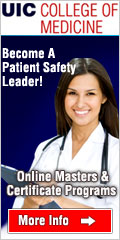

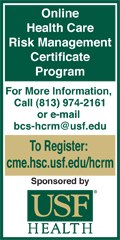





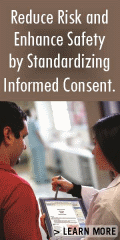

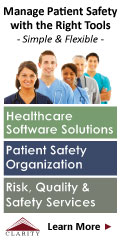

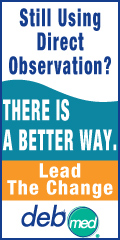





|
 |



